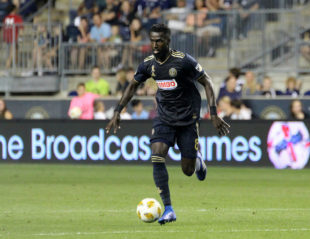Feature image PSP archives
The Derrick Jones trade is right on time.
Time is a flow
Historically time has always been conceived as moving forward. The forward motion may be linear as in the west, or of a more complex pattern as in the reincarnation-based cycles of eastern thought. But both move forward.
When the primary mode of human economic production was agricultural, crop farming and animal husbandry as examples, time was more flexible, less precise.
Once industrialization began, coordinating many people to maximize production required time to become much less flexible. Nineteenth century clock towers such as in Waterbury, Connecticut or Big Ben in London, exemplify the new precision.
Keystone’s countdown clock
As soon as a player for one of Keystone Sports and Entertainment’s soccer teams wins promotion to the next level, his personal countdown clock starts anew. While a player is in the academy, the clock’s time period is the birth year.
As a general principle once a player becomes a professional with Bethlehem, the time period is 12 to 24 months. Steel FC head coach Brendan Burke stated the numbers directly when explaining 2017 and 2018 end-of-season decisions.
Consider Jones
Derrick Jones signed in early December of 2015 as Bethlehem Steel FC’s first professional player. He had been playing for the academy and taking courses at the Academy schoolhouse as a postgraduate in the classroom anticipating a possible NCAA future.
Seven months later he was the first player signed from the Bethlehem “stepping stone” to the Union, in July of 2016. He demonstrated how the stepping stone was going to work. He began to practice every day with the first-team but continued to play his games with Bethlehem.
Jones earned chances to play for the first team, but never consistently. A two-year descriptive theme from first-team head coach Jim Curtin centered around wanting more. Sometimes there were specific technical behaviors, but more often “more” remained publicly intangible.
At the end of 24 months in July of 2018, after most recently replacing Bethlehem’s injured captain at defensive center midfielder, and doing it effectively in terms of club wins and losses, Jones stopped appearing for the Steel and began to appear in the Union’s gameday 18 with some consistency. The transition occurred as Earnie Stewart handed over to Ernst Tanner.
An evaluation
That a new sporting director would want time to get to know his players and form fair, nuanced judgments seems clear. Last week, 34 months after his first-team signing, the judgment became public.
Derrick Jones has never demonstrated long-range offensive distribution from the defensive central midfield. He is neither Vince Nogueira, Haris Medunjanin, nor James Chambers. His offensive contributions come from the dribble – at the USL level he has become a formidable threat to carry the ball into the attack – and from short-distance combination play. But he is not the complete number six the organization wants at that spot.
During preseason he played the wide positions of the midfield diamond. The decision to bring in Jamiro Monteiro demonstrates the level of play that Ernst Tanner and Jim Curtin want from central midfielders playing its outside corners. And it suggests the technical staff’s judgment of Jones’s adaptation.
Only once in his time with the organization did Jones show clear success at attacking center mid. In the first half of the Rochester Rhino’s visit to Goodman Stadium in 2016, Jones stacked behind Seku Conneh at striker, and played short passes on the ground to Conneh checking back. Not only did the Steel score, they forced the Rhinos to improvise a formation change at halftime.
Jones is a strong defender at all these midfield positions. He is an effective ball winner capable of holding it successfully against multiple opponents combining to pressure him. But he does not have the full range of offensive skills in the consistency and frequency the organization wants, the long-range passing dimension.
And, perhaps because 22-year-old Jones still has value in the eyes of others as a candidate for future development, he is gone and 28-year-old Warren Creavalle continues as the similarly limited midfield backup.
Change of scene
Characterizing a separation as a mutual desire for scenery change gently hints at mutual frustration. Tanner’s words, and the process behind them, do not seem abrupt. Derrick Jones growth as a player is best served elsewhere, and the organization has recognized that. Caring enough about the player to realize that keeping him does no one any good is a responsible approach.
They have been unable to find Jones’s “key.”
Brendan Burke was frustrated and sad two years ago that he had not found the key to Yosef Samuel. As Steel fans may have noticed Sunday night, Samuel is still playing professionally for Atlanta United 2. Eagles fans will remember that under different circumstances Buddy Ryan sent Chris Carter away, triggering a hall of fame career.
Hopefully something like that will work out for Derrick Jones.


Excellent work
Thank you, El P.
.
After I had turned the article over to the editors Tuesday evening, I watched a piece or two of Nashville SC’s U. S. Open Cup match, and happened to notice Jones being subbed off at the 75th minute mark, give or take.
.
Nashville seems to like Brendan Burke players. They have four from Bethlehem: Ken Tribbett, Bolu Akinyode, Taylor Washington and now Jones.
Good read Tim. I feel like everyone wanted Jones to succeed. It’s nice to know the organization has both the player and its own interests in mind when they make their decisions. Thanks for the info!
What is really nice is it appears we have a sporting director with a true feel for the clock and timing. He appears to striking deals at the right time as opposed to too late or too early,
Here is Jonesey after his Nashville FC debut: